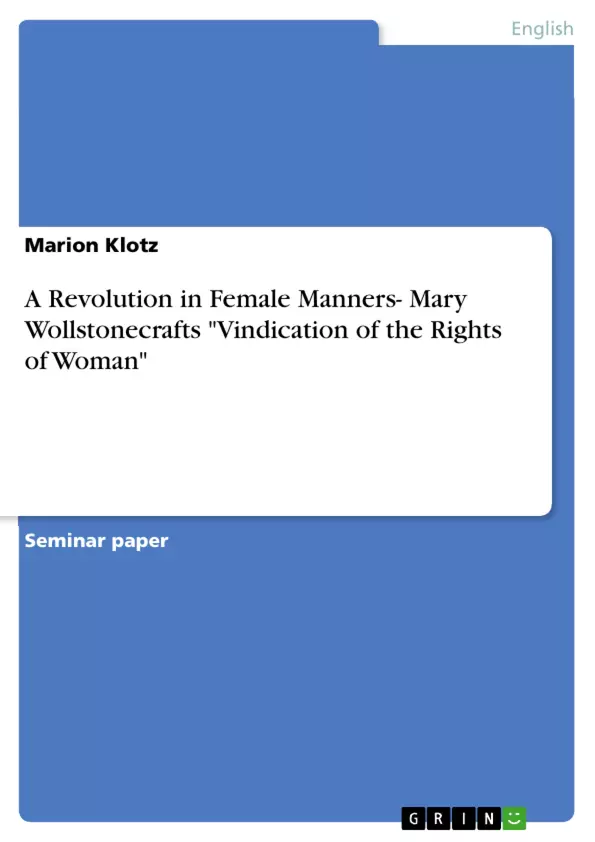„The fear of innovation, in this country, extends to every thing“ mourns Mary Wollstonecraft in her Vindication of the Rights of Woman in 1792 (254). At this time, women were thought to be inferior to men and did not have any legal rights. As a well-educated and very intelligent woman, Wollstonecraft could hardly bare to see her fellow women trudge through life not even noticing that they were suppressed by an unjust system of slave-like subjugation. A Vindication of the Rights of Woman therefore aimed at changing public perception of women and showing ways to improve women‘s rights in society.
In this paper I will try to point out the main arguments of A Vindication of the Rights of Woman and the way they are built upon one another. In Wollstonecraft‘s work there is no real distinction between the different points as they are interwoven in cultural and social life as well. For the reader nowadays, however, I thought it to be more convenient to first understand what the situation for women in Wollstonecraft‘s time was like and how, always according to Wollstonecraft‘s own description, they were perceived in society. Her own perception of woman will round up the first chapter of this paper.
The next point will deal with the relation between the sexes; mainly with the way women are suppressed by men and how this subjugation could be rendered more just.
This leads to the main point of the argument, which is the emancipation of women. In this chapter I will concentrate on the reasons for female emancipation, the means of its achievement and the effects it would have on society.
In the last chapter I will draw a conclusion which will bring the main arguments together, briefly deal with some of the consequences and compare Mary Wollstonecraft with other female writers of her time.
Table of Contents
- Introduction
- On the Perception of Woman
- In the Perception of Society
- From Wollstonecraft's Point of View
- On the Relation between the Sexes
- Man's Subjugation of Woman
- Free Choice of Partners
- On Female Emancipation
- Reasons for Its Necessity
- Ways of Realisation
- Effects on Society
- Conclusion
Objectives and Key Themes
This paper explores Mary Wollstonecraft's A Vindication of the Rights of Woman, examining its main arguments and how they intertwine to advocate for female emancipation. It aims to provide a comprehensive understanding of Wollstonecraft's perspective on women's societal position, their perception, and the unjust subjugation they face.
- Women's Perception in Society
- The Tyranny of Man over Woman
- The Need for Female Emancipation
- Ways to Achieve Female Emancipation
- The Impact of Female Emancipation on Society
Chapter Summaries
The introduction contextualizes A Vindication of the Rights of Woman within the social and political climate of 18th-century England, highlighting the prevailing view of women as inferior and the lack of legal rights they possessed. It sets the stage for Wollstonecraft's argument for a more just society, emphasizing the need for a revolution in female manners.
The first chapter delves into the perception of women in society. Wollstonecraft critiques the prevailing view of women as docile, dependent, and primarily focused on pleasing men. She challenges the notion that women are inherently less intelligent than men, arguing that societal structures and a lack of education contribute to their seemingly inferior status.
The second chapter focuses on the relationship between the sexes, particularly the subjugation of women by men. Wollstonecraft attributes this subjugation to societal structures and historical views that have perpetuated a power imbalance between men and women. She challenges the notion that women were created solely for men, arguing for a more equitable and just relationship.
The third chapter presents the core argument for female emancipation. Wollstonecraft outlines the reasons for its necessity, including the need for women to achieve greater autonomy, personal fulfillment, and intellectual development. She explores various ways to achieve female emancipation, including education, legal reforms, and a shift in societal attitudes.
Keywords
The core concepts in this work revolve around female emancipation, gender equality, societal structures, the perception of women, the relationship between the sexes, and the impact of education on female development. It further explores themes of intellectual freedom, autonomy, and the need for a revolution in female manners.
- Citar trabajo
- Marion Klotz (Autor), 2003, A Revolution in Female Manners- Mary Wollstonecrafts "Vindication of the Rights of Woman", Múnich, GRIN Verlag, https://www.grin.com/document/33534



